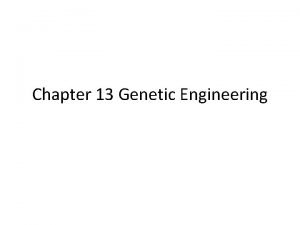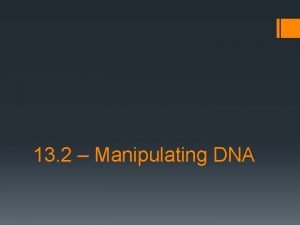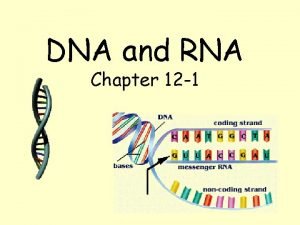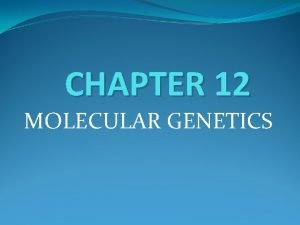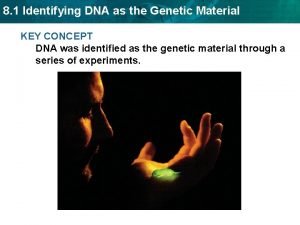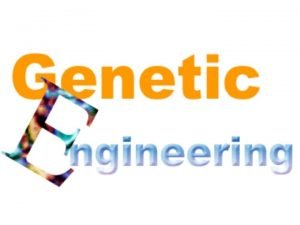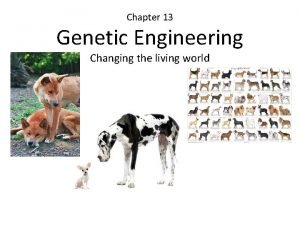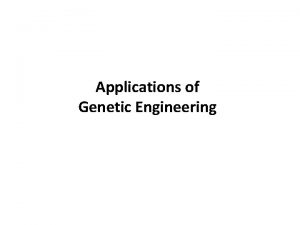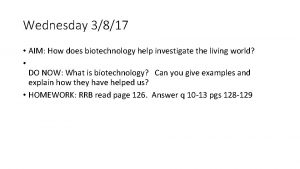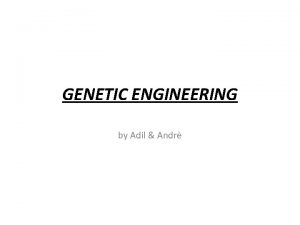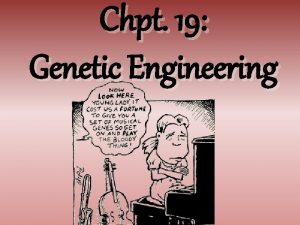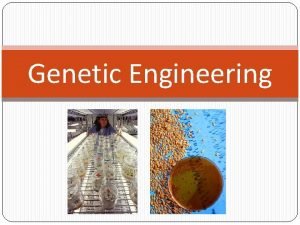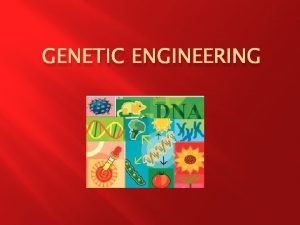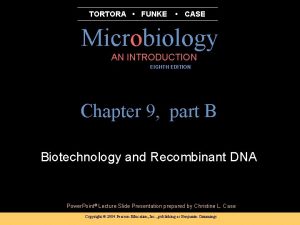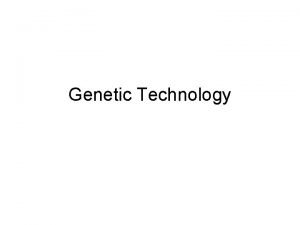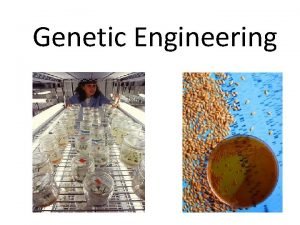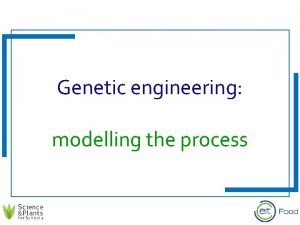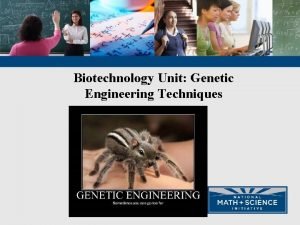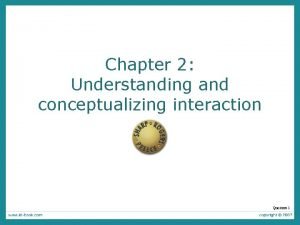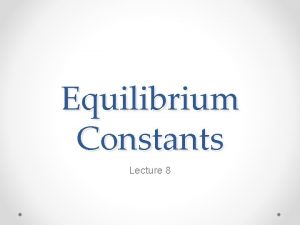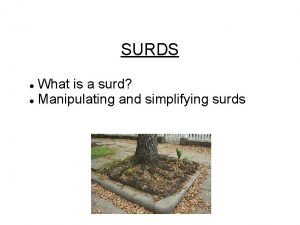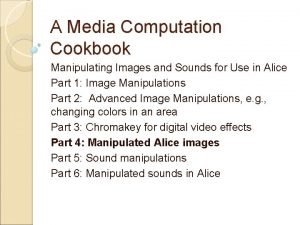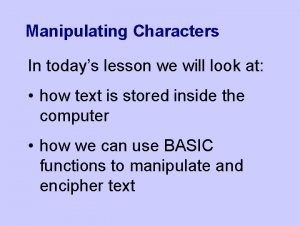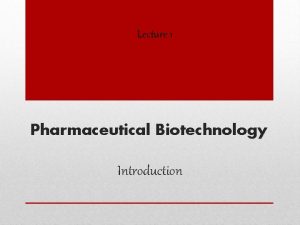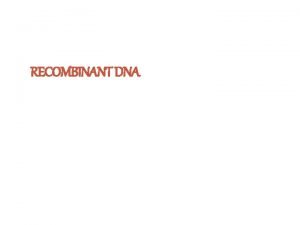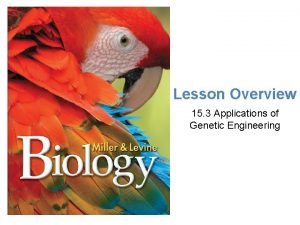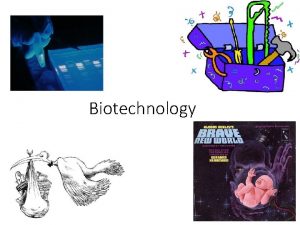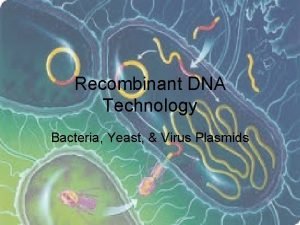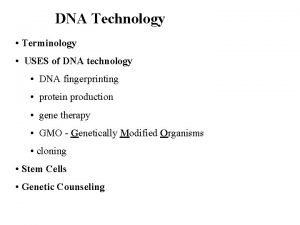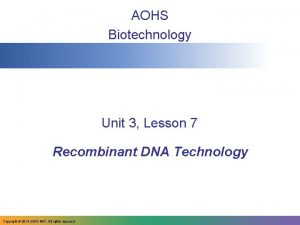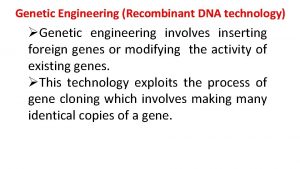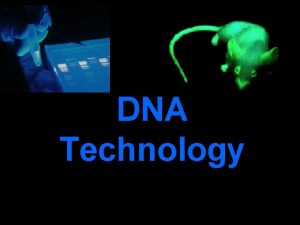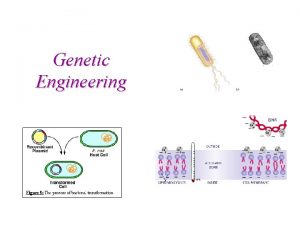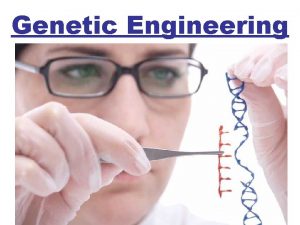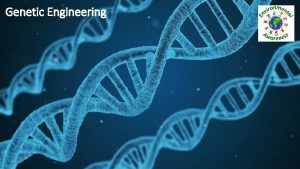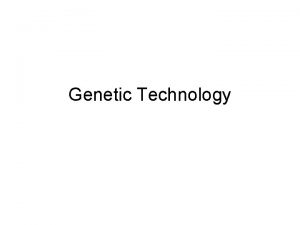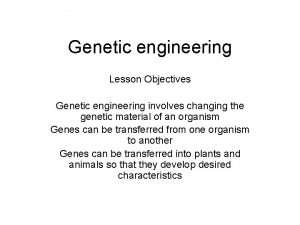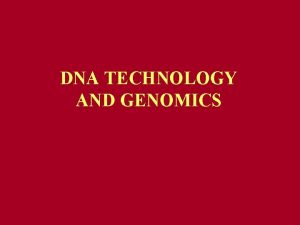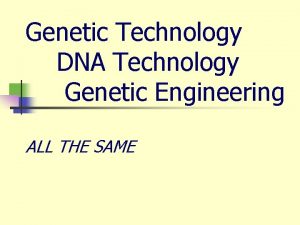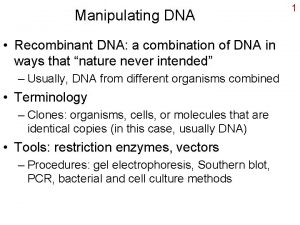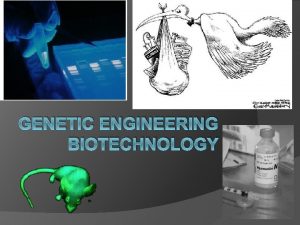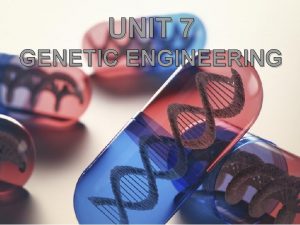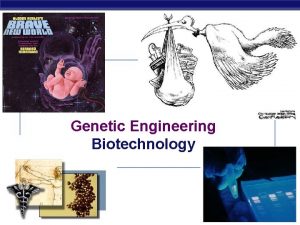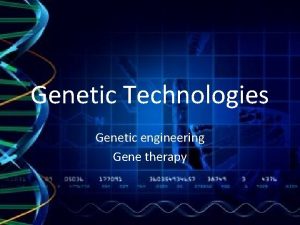Chapter 20 DNA Technology Genetic engineering involves manipulating






















































- Slides: 54

Chapter 20 : DNA Technology § Genetic engineering involves manipulating genes for practical purposes – Gene cloning leads to the production of multiple identical copies of a gene-carrying piece of DNA – Recombinant DNA is formed by joining DNA sequences from two different sources – One source contains the gene that will be cloned – Another source is a gene carrier, called a vector – Plasmids (small, circular DNA molecules independent of the bacterial chromosome) are often used as vectors Copyright © 2009 Pearson Education, Inc.

Genes can be cloned in recombinant plasmids § Steps in cloning a gene 1. Plasmid DNA is isolated 2. DNA containing the gene of interest is isolated 3. Plasmid DNA is treated with restriction enzyme that cuts in one place, opening the circle 4. DNA with the target gene is treated with the same enzyme and many fragments are produced 5. Plasmid and target DNA are mixed and associate with each other Copyright © 2009 Pearson Education, Inc.

Genes can be cloned in recombinant plasmids 6. Recombinant DNA molecules are produced when DNA ligase joins plasmid and target segments together 7. The recombinant DNA is taken up by a bacterial cell 8. The bacterial cell reproduces to form a clone of cells Copyright © 2009 Pearson Education, Inc.

E. coli bacterium Plasmid Bacterial chromosome 1 Cell with DNA containing gene of interest Isolate plasmid 3 Isolate DNA 2 Cut plasmid with enzyme DNA Gene of interest 4 Cut cell’s DNA with same enzyme Gene of interest 5 6 Recombinant DNA plasmid Combine targeted fragment and plasmid DNA Add DNA ligase, which closes the circle with covalent bonds Genes may be inserted into other organisms Gene of interest 7 Put plasmid into bacterium by transformation Recombinant bacterium 8 Clone of cells Examples of gene use Allow bacterium to reproduce 9 Genes or proteins are isolated from the cloned bacterium Harvested Examples of proteins protein use may be used directly

E. coli bacterium Plasmid Bacterial chromosome 1 Isolate plasmid Cell with DNA containing gene of interest 2 Isolate DNA Gene of interest

E. coli bacterium Plasmid Bacterial chromosome 1 Cell with DNA containing gene of interest Isolate plasmid 3 2 Cut plasmid with enzyme Isolate DNA Gene of interest 4 Gene of interest Cut cell’s DNA with same enzyme

E. coli bacterium Plasmid Bacterial chromosome 1 Cell with DNA containing gene of interest Isolate plasmid 3 2 Cut plasmid with enzyme Isolate DNA Gene of interest 4 Cut cell’s DNA with same enzyme Gene of interest 5 Combine targeted fragment and plasmid DNA

E. coli bacterium Plasmid Bacterial chromosome 1 Cell with DNA containing gene of interest Isolate plasmid 3 2 Cut plasmid with enzyme Isolate DNA Gene of interest 4 Cut cell’s DNA with same enzyme Gene of interest Recombinant DNA plasmid 5 Combine targeted fragment and plasmid DNA 6 Add DNA ligase, which closes the circle with covalent bonds Gene of interest

Recombinant DNA plasmid Gene of interest 7 Recombinant bacterium Put plasmid into bacterium by transformation

Recombinant DNA plasmid Gene of interest 7 Put plasmid into bacterium by transformation Recombinant bacterium 8 Clone of cells Allow bacterium to reproduce

Examples of gene use Genes may be inserted into other organisms Recombinant DNA plasmid Gene of interest 7 Put plasmid into bacterium by transformation Recombinant bacterium 8 Allow bacterium to reproduce 9 Genes or proteins are isolated from the cloned bacterium Harvested proteins may be used directly Clone of cells Examples of protein use

Enzymes are used to “cut and paste” DNA § Restriction enzymes (aka ENDONUCLEASES) cut DNA at specific sequences – Each enzyme binds to DNA at a different restriction site – Many restriction enzymes make staggered cuts that produce restriction fragments with single-stranded ends called “sticky ends” – Fragments with complementary sticky ends can associate with each other, forming recombinant DNA § DNA ligase joins DNA fragments together Copyright © 2009 Pearson Education, Inc.

Restriction enzyme recognition sequence 1 DNA Restriction enzyme cuts the DNA into fragments 2 Sticky end

Restriction enzyme recognition sequence 1 DNA Restriction enzyme cuts the DNA into fragments 2 Sticky end Addition of a DNA fragment from another source 3

Restriction enzyme recognition sequence 1 DNA Restriction enzyme cuts the DNA into fragments 2 Sticky end Addition of a DNA fragment from another source Two (or more) fragments stick together by base-pairing 4 3

Restriction enzyme recognition sequence 1 DNA Restriction enzyme cuts the DNA into fragments 2 Sticky end Addition of a DNA fragment from another source 3 Two (or more) fragments stick together by base-pairing 4 DNA ligase pastes the strands 5 Recombinant DNA molecule

Cloned genes can be stored in genomic libraries § A genomic library is a collection of all of the cloned DNA fragments from a target genome § Genomic libraries can be constructed with different types of vectors – Plasmid library: genomic DNA is carried by plasmids – Phage library: genomic DNA is incorporated into bacteriophage DNA – Bacterial artificial chromosome (BAC) library: specialized plasmids can carry large DNA sequences Copyright © 2009 Pearson Education, Inc.

Genome cut up with restriction enzyme Recombinant plasmid Recombinant phage DNA or Bacterial clone Plasmid library Phage clone Phage library

Reverse transcriptase can help make genes for cloning § Complementary DNA (c. DNA) is used to clone eukaryotic genes – m. RNA from a specific cell type is the template – Reverse transcriptase produces a DNA strand from m. RNA – DNA polymerase produces the second DNA strand § Advantages of cloning with c. DNA – Study genes responsible for specialized characteristics of a particular cell type – Obtain gene sequences without introns – Smaller size is easier to handle – Allows expression in bacterial hosts Copyright © 2009 Pearson Education, Inc.

Cell nucleus DNA of eukaryotic gene Exon Intron Exon 1 Transcription RNA transcript 2 RNA splicing m. RNA 3 Isolation of m. RNA Test tube Reverse transcriptase c. DNA strand being synthesized and addition of reverse transcriptase; synthesis of DNA strand 4 Breakdown of RNA 5 Synthesis of second DNA strand c. DNA of gene (no introns)

Nucleic acid probes identify clones carrying specific genes § Nucleic acid probes bind to cloned DNA – Probes can be DNA or RNA sequences complementary to a portion of the gene of interest – A probe binds to a gene of interest by base pairing – Probes are labeled with a radioactive isotope or fluorescent tag for detection Copyright © 2009 Pearson Education, Inc.

Nucleic acid probes identify clones carrying specific genes § Screening a gene library – Bacterial clones are transferred to filter paper – Cells are lysed and DNA is separated into single strands – A solution containing the probe is added, and binding to the DNA of interest is detected – The clone carrying the gene of interest is grown for further study Copyright © 2009 Pearson Education, Inc.

Radioactive DNA probe Mix with singlestranded DNA from genomic library Single-stranded DNA Base pairing indicates the gene of interest

GENETICALLY MODIFIED ORGANISMS Copyright © 2009 Pearson Education, Inc.

Recombinant cells and organisms can mass-produce gene products § Cells and organisms containing cloned genes are used to manufacture large quantities of gene products § Capabilities of the host cell are matched to the characteristics of the desired product – Prokaryotic host: E. coli – Can produce eukaryotic proteins that do not require posttranslational modification – Has many advantages in gene transfer, cell growth, and quantity of protein production – Can be engineered to secrete proteins Copyright © 2009 Pearson Education, Inc.

Recombinant cells and organisms can mass-produce gene products § Capabilities of the host cell are matched to the characteristics of the desired product – Eukaryotic hosts – Yeast: S. cerevisiae – Can produce and secrete complex eukaryotic proteins – Mammalian cells in culture – Can attach sugars to form glycoproteins – “Pharm” animals – Will secrete gene product in milk Copyright © 2009 Pearson Education, Inc.


DNA technology has changed the pharmaceutical industry and medicine § Products of DNA technology – Therapeutic hormones – Insulin to treat diabetes – Human growth hormone to treat dwarfism – Diagnosis and treatment of disease – Testing for inherited diseases – Detecting infectious agents such as HIV Copyright © 2009 Pearson Education, Inc.

DNA technology has changed the pharmaceutical industry and medicine § Products of DNA technology – Vaccines – Stimulate an immune response by injecting – Protein from the surface of an infectious agent – A harmless version of the smallpox virus containing genes from other infectious agents Copyright © 2009 Pearson Education, Inc.

DNA technology has changed the pharmaceutical industry and medicine § Advantages of recombinant DNA products – Identity to human protein – Purity – Quantity Copyright © 2009 Pearson Education, Inc.


Genetically modified organisms are transforming agriculture § Genetically modified (GM) organisms contain one or more genes introduced by artificial means § Transgenic organisms contain at least one gene from another species § GM plants – Resistance to herbicides – Resistance to pests – Improved nutritional profile § GM animals – Improved qualities – Production of proteins or therapeutics Copyright © 2009 Pearson Education, Inc.

Agrobacterium tumefaciens DNA containing gene for desired trait 1 Ti plasmid Insertion of gene into plasmid Restriction site Recombinant Ti plasmid

Agrobacterium tumefaciens Plant cell DNA containing gene for desired trait 1 Ti plasmid Insertion of gene into plasmid Recombinant Ti plasmid 2 Introduction into plant cells DNA carrying new gene Restriction site

Agrobacterium tumefaciens Plant cell DNA containing gene for desired trait 1 Ti plasmid Insertion of gene into plasmid Recombinant Ti plasmid 3 2 Introduction into plant cells Regeneration of plant DNA carrying new gene Restriction site Plant with new trait


Genetically modified organisms raise concerns about human and environmental health § Scientists use safety measures to guard against production and release of new pathogens § Concerns related to GM organisms – Can introduce allergens into the food supply – FDA requires evidence of safety before approval – Exporters must identify GM organisms in food shipments – May spread genes to closely related organisms – Hybrids with native plants may be prevented by modifying GM plants § Regulatory agencies address the safe use of biotechnology Copyright © 2009 Pearson Education, Inc.

Gene therapy may someday help treat a variety of diseases § Gene therapy aims to treat a disease by supplying a functional allele § One possible procedure – Clone the functional allele and insert it in a retroviral vector – Use the virus to deliver the gene to an affected cell type from the patient, such as a bone marrow cell – Viral DNA and the functional allele will insert into the patient’s chromosome – Return the cells to the patient for growth and division Copyright © 2009 Pearson Education, Inc.

DNA PROFILING Copyright © 2009 Pearson Education, Inc.

The analysis of genetic markers can produce a DNA profile § DNA profiling is the analysis of DNA fragments to determine whether they come from a particular individual – Compares genetic markers from noncoding regions that show variation between individuals – Involves amplification (copying) of markers for analysis – Sizes of amplified fragments are compared Copyright © 2009 Pearson Education, Inc.

Crime scene 1 DNA isolated 2 DNA of selected markers amplified 3 Amplified DNA compared Suspect 1 Suspect 2

The PCR method is used to amplify DNA sequences § Polymerase chain reaction (PCR) is a method of amplifying a specific segment of a DNA molecule § Relies upon a pair of primers – Short DNA molecules that bind to sequences at each end of the sequence to be copied – Used as a starting point for DNA replication § Repeated cycle of steps for PCR – Sample is heated to separate DNA strands – Sample is cooled and primer binds to specific target sequence – Target sequence is copied with heat-stable DNA polymerase Copyright © 2009 Pearson Education, Inc.

The PCR method is used to amplify DNA sequences § Advantages of PCR – Can amplify DNA from a small sample – Results are obtained rapidly – Reaction is highly sensitive, copying only the target sequence Copyright © 2009 Pearson Education, Inc.

Cycle 1 yields 2 molecules Genomic DNA 3 1 3 5 3 Target sequence 5 5 5 3 Cycle 2 yields 4 molecules 5 5 2 Cool to allow 3 Heat to primers to form separate DNA strands hydrogen bonds with ends of target sequences 5 3 5 3 Primer 3 5 DNA polymerase adds nucleotides to the 3 end of each primer 5 3 New DNA Cycle 3 yields 8 molecules

Cycle 1 yields 2 molecules Genomic DNA 3 3 5 5 3 Target sequence 5 3 3 5 5 3 2 Cool to allow 1 Heat to primers to form separate DNA strands hydrogen bonds with ends of target sequences 5 5 3 Primer 5 DNA polymerase adds nucleotides to the 3 end of each primer 5 3 New DNA

Cycle 2 yields 4 molecules Cycle 3 yields 8 molecules

Gel electrophoresis sorts DNA molecules by size § Gel electrophoresis separates DNA molecules based on size – DNA sample is placed at one end of a porous gel – Current is applied and DNA molecules move from the negative electrode toward the positive electrode – Shorter DNA fragments move through the gel pores more quickly and travel farther through the gel – DNA fragments appear as bands, visualized through staining or detecting radioactivity or fluorescence – Each band is a collection of DNA molecules of the same length Copyright © 2009 Pearson Education, Inc.

Mixture of DNA fragments of different sizes Power source Longer (slower) molecules Gel Shorter (faster) molecules Completed gel

STR analysis is commonly used for DNA profiling § Short tandem repeats (STRs) are genetic markers used in DNA profiling – STRs are short DNA sequences that are repeated many times in a row at the same location – The number of repeating units can differ between individuals – STR analysis compares the lengths of STR sequences at specific regions of the genome – Current standard for DNA profiling is to analyze 13 different STR sites Copyright © 2009 Pearson Education, Inc.

STR site 1 STR site 2 Crime scene DNA Number of short tandem repeats match repeats do not match Suspect’s DNA

Crime scene DNA Suspect’s DNA

DNA profiling has provided evidence in many forensic investigations § Forensics – Evidence to show guilt or innocence § Establishing family relationships – Paternity analysis § Identification of human remains – After tragedies such as the September 11, 2001, attack on the World Trade Center § Species identification – Evidence for sale of products from endangered species Copyright © 2009 Pearson Education, Inc.

RFLPs can be used to detect differences in DNA sequences § Single nucleotide polymorphism (SNP) is a variation at one base pair within a coding or noncoding sequence § Restriction fragment length polymorphism (RFLP) is a variation in the size of DNA fragments due to a SNP that alters a restriction site – RFLP analysis involves comparison of sizes of restriction fragments by gel electrophoresis Copyright © 2009 Pearson Education, Inc.

Restriction enzymes added DNA sample 1 DNA sample 2 w Cut z x Cut y y Longer fragments z x Shorter fragments w y y
 13-2 manipulating dna
13-2 manipulating dna 13-2 manipulating dna
13-2 manipulating dna Grabber
Grabber Molecular genetics section 1 dna the genetic material
Molecular genetics section 1 dna the genetic material Chapter 12 section 1 molecular genetics answer key
Chapter 12 section 1 molecular genetics answer key Chapter 12 molecular genetics answer key
Chapter 12 molecular genetics answer key Chapter 12 dna the genetic material
Chapter 12 dna the genetic material Section 12-1 dna
Section 12-1 dna Gene pool
Gene pool Genetic programming vs genetic algorithm
Genetic programming vs genetic algorithm Genetic programming vs genetic algorithm
Genetic programming vs genetic algorithm What is gene flow and genetic drift
What is gene flow and genetic drift What is the difference between genetic drift and gene flow
What is the difference between genetic drift and gene flow Section 1 identifying dna as the genetic material
Section 1 identifying dna as the genetic material Insulin bacteria genetic engineering
Insulin bacteria genetic engineering Section 13-1 changing the living world
Section 13-1 changing the living world Genetic engineering
Genetic engineering How is selective breeding accomplished
How is selective breeding accomplished Purpose of genetic engineering
Purpose of genetic engineering Genetic engineering conclusion
Genetic engineering conclusion Oryx and crake genetic engineering
Oryx and crake genetic engineering Research on the pros and cons of genetic engineering.
Research on the pros and cons of genetic engineering. Steps in genetic engineering
Steps in genetic engineering Bioluminescence genetic engineering
Bioluminescence genetic engineering Objectives of genetic engineering for class 10
Objectives of genetic engineering for class 10 Agrobacterium tumefaciens genetic engineering
Agrobacterium tumefaciens genetic engineering Genetic engineering
Genetic engineering Genetic engineering
Genetic engineering Genetic engineering
Genetic engineering Genetic engineering
Genetic engineering Lady macbeth manipulation quotes and techniques
Lady macbeth manipulation quotes and techniques Instructing conversing manipulating exploring
Instructing conversing manipulating exploring Staar content and language supports
Staar content and language supports Manipulating large data sets
Manipulating large data sets Equiibrium constant
Equiibrium constant What are two most important requirements for scalp care
What are two most important requirements for scalp care Algebraic fraction
Algebraic fraction √8+√2
√8+√2 Process of manipulating images and sounds
Process of manipulating images and sounds Ascii of space
Ascii of space Dna polymerase function in dna replication
Dna polymerase function in dna replication Bioflix activity dna replication lagging strand synthesis
Bioflix activity dna replication lagging strand synthesis Coding dna and non coding dna
Coding dna and non coding dna The principal enzyme involved in dna replication is
The principal enzyme involved in dna replication is Dna rna protein synthesis homework #2 dna replication
Dna rna protein synthesis homework #2 dna replication Technology involves
Technology involves Recombinant dna technology applications
Recombinant dna technology applications Recombinant dna technology applications
Recombinant dna technology applications Define recombinant dna technology
Define recombinant dna technology Complementary genes example
Complementary genes example Recombinant dna technology applications
Recombinant dna technology applications Which career combines dna technology and forensics
Which career combines dna technology and forensics Recombinant dna
Recombinant dna Recombinant dna technology
Recombinant dna technology Recombinant dna technology
Recombinant dna technology
